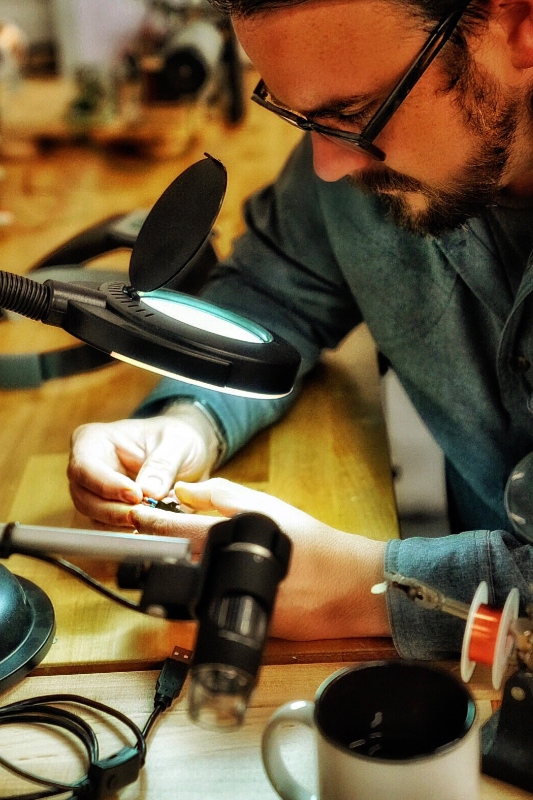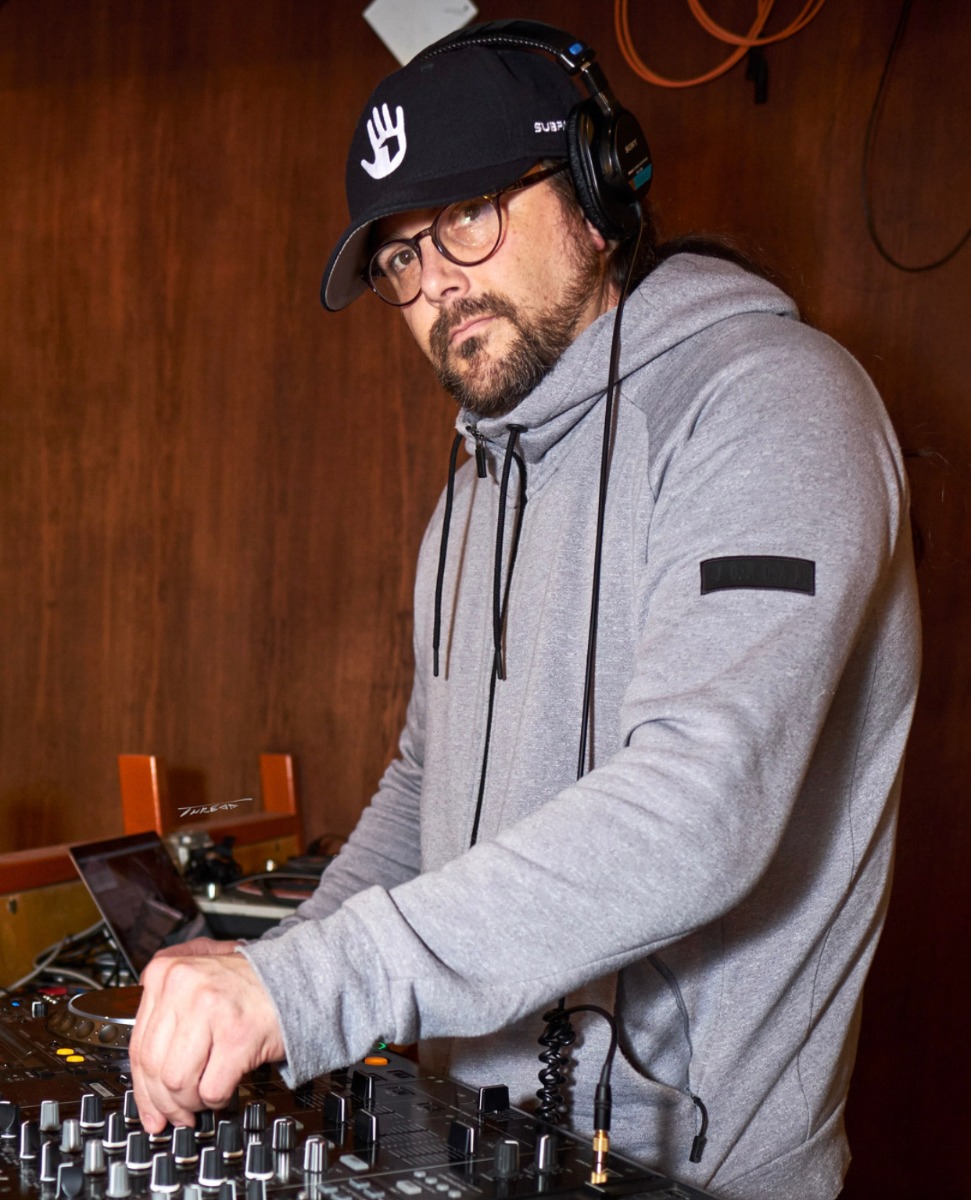Many would agree that listening to music is one of the most pleasurable activities life can offer—and with the exponential advancement of audio technology over the last decades, the quality of sound provided by modern tools is quite astonishing. We are at a point where comparisons are seldom about the difference between 'good' vs 'bad' sound, and more often about 'good' vs 'great'. Among the various kinds of listening devices, headphones are perhaps some of the most cherished and personal, as they allow us to take our favorite medium with us wherever we go. And while there are many good headphones to choose from in today's world...there are also some great ones.
Today we are talking with Alex Rosson from Rosson Audio, the company that gave the world the unique RAD-0 open-back headphones...headphones which undoubtedly can be placed in the 'great' category. Alex is an experienced audio engineer, the founder and an ex-CEO of Audeze, and half the force behind the label Play Me Records, which he runs with his wife Reid Speed. In this interview Alex shares with us his passion for designing amazing headphones, some of his favorite music, and tells the story of his career.
PC: Hello Alex! Thank you for talking with us. Let us start with your background. Can you tell us a little bit about yourself? What is your background in the world of professional audio? And how did that lead you to start making headphones?
AR: Music has been at the center of my life from a young age, playing drums, DJing D&B, and producing electronic music. I became fascinated with recording at a young age hanging out at my uncle’s studio The Village. I decided to go to school to become a “certified” recording engineer and landed a job at LA studios, where I had the opportunity to train my ear and learn how to run a studio, as well as gain a desire for cutting-edge audio gear. I spent a lot of time learning about and maintaining the equipment we used as well as continuing with my own tinkering at home building speaker systems and drooling over gear. Fast forward and skipping ahead, I moved on to serve as a Mastering Engineer, Senior Systems Engineer, and Head of Data Management for Technicolor, where I was responsible for global workflow design and implementation, infrastructure design, product sourcing, development, beta testing and global integration.
While nearing a decade at Technicolor I founded Audeze with the mission to provide the world with audio solutions that deliver the most accurate sound reproduction possible, exceptional dynamics and authority. All while moonlighting, I managed to build Audeze into an industry leader for high-end audio products. With some luck we managed to attract the attention of Atlantic Records CEO, Craig Kallman who shared my interest in quality and how we listen to music. After getting to know each other we sought to form a strategic partnership between Audeze and Warner Music Group. This not only enabled me to quit my day job—it allowed for growth and the development of new products, which in turn led to a collaboration with BMW. In 2015 after guiding Audeze to a strong place I felt the need to explore other opportunities and stepped down as CEO.
I accepted a position as Director of Audio for Shinola Detroit where we designed built turntables, bookshelf speakers, and headphones. It was an amazing challenge and experience that I will never forget. After the work I did at Shinola I decided to start over again and the RAD-0’s development immediately began.
PC: Can you tell us what planar magnetic technology is and what sets it apart from dynamic headphone design?
AR: A planar magnetic transducer functions differently than dynamic drivers by using a flat and extremely thin diaphragm (membrane) that has the conductor trace embedded directly on the surface, which allows the entire surface to simultaneously react once placed within a magnetic field. In contrast, dynamic drivers use a voice coil to move a diaphragm, usually shaped like a cone, and made from paper or composite material. While both types of drivers use pistonic movement, having the conductor directly on the flat surface of a planar diaphragm can often have an advantage by producing a much more even physical movement compared to dynamic drivers. However, each type has its optimal application. For example, while planar is capable of full range reproduction, making it perfect for headphones, you wouldn’t typically utilize planars for subwoofers.

PC: What are the main challenges in designing headphones in general, and specifically headphones that are suited for studio work?
AR: That’s a tricky question. No matter what you want to make, a speaker, a headphone, a turntable, even though all are in the audio realm, every project is way more different from one another than one may think. Every project will have different limitations that you have to work with whether it’s industrial design, mechanical acoustic engineering, budgetary, etc. Because of this, designing two headphones is just as different as designing a headphone and a turntable. However, finding great partners and vendors to work with, as well as getting your team on the same mission and making them enthusiastic about it will always be important, no matter what.
PC: It looks like the production line is made up entirely of open-back headphones. Why do you prefer them over closed-back designs?
AR: We do plan on offering a closed back version or conversion kit in the future, but for now, we are focused on performance.
Compared to closed back, open-backed headphones allow air to escape the headphone, which in turn reduces resonant cavity effects and can provide cross-feed. For critical monitoring open back headphones are my preference. The RAD-0 transducer is dipole, and air is excited on both the inside and outside. We angle our transducer with our earpads to focus the air as it reaches your ears. It then bounces around and eventually finds its escape out of the headphone. When you close a headphone the air gets trapped all around the inside of the enclosure, which can cause resonance and potential cancellation.
That said, I don’t necessarily prefer open back over closed back. I prefer each type for their application. For example If I’m tracking or on a plane it’s rare that I will wear open back headphones due to leakage. Again, I do plan on offering a closed back version or conversion kit in the future, but for now, we are focused on performance.
PC: In your opinion what sets RAD-O apart from other audiophile grade headphones?
AR: We work hard to stay a small team. As a result, everybody does a little bit of everything. From the aesthetics to the frequency response, it’s clear that every unit is a collaboration and a culmination of a full team’s work and expertise. Every unit feels special because every unit is special to us, we make headphones that we want to keep for ourselves but cannot. Something we’re really proud to be able to do, and that’s unique to us, is the deep level of customization available in our Custom Shop, where we can build a headphone to your desired specs. Ultimately, it's about the audio performance quality, and RAD-0 bridges audio listening pleasure with precision that is universally desired but difficult to execute well and consistently.
PC: Why is a handmade, one-of-a-kind approach to production important to you?
AR: I wanted to make a statement with the RAD-0 that it's possible to provide a reference grade monitoring device inside a one of a kind work of art. It’s unique and rewarding for an object to shine as both on display and as a reference level headphone.
PC: Who do you feel would benefit the most from RAD-0 headphones?
AR: Anyone who needs to be able to dissect each layer of a mix or sound with accurate monitoring. Musicians, producers, mixing and mastering engineers.
I find those that may not have a dedicated studio but are looking to take their skill to the next level and may not be able to afford $10k+ speakers or might have poor room acoustics. One example are young producers and students. We love helping students and they have become a gratifying segment of our customers. If you are a student and looking to up your game don’t hesitate to reach out.

PC: What defines for you the most fulfilling listening experience?
AR: Acoustic analog waves created by a live orchestra, or anytime I get goosebumps.
Other than that, the zen that occurs while playing an instrument.
PC: Do you feel that the headphones you design shine the most when paired with certain equipment? If so, what would be your recommendations?
AR: In my opinion, there is no best, there is only character. It’s all subjective and everybody hears differently. Yes, certain pieces of gear can measure and perform technically better on paper, but that doesn't necessarily mean they sound better. I like to think every piece of gear and genre of music has a certain character and or soul.
Any speaker or headphone is going to benefit from dedicated equipment, whether it be a well-designed amplifier or DAC. In general, you'll get the most out of your headphones with at least one watt of power, however it is not necessary and our headphones sound amazing plugged into most gear, even your cell phone.
That doesn’t mean I don’t gravitate towards certain gear. For example I’ve been using the Rupert Neve Designs Fidelis Precision DAC Amp and while I may be biased, being a huge RND fanboy, there’s something about this amp DAC that’s really enjoyable to listen to when paired with our headphones. Another one would have to be the Mal Valve made by a bespoke German company. It's a beast of an amp filled with tubes. Those two amps are a financial stretch for some, however, our friends over at head amp make amazing amps, like the Gilmore MK2, that provide more than enough power and clean signal. Some other brands I gravitate towards are Violectric, Mytech, SPL, and Chord.

PC: Are you working on any other models of headphones at the moment?
AR: In short, always. We are always working on improving current models while dreaming up the next one. We do have some concepts and designs that have been getting more attention internally, but my motto lately has been 'do one thing well', and so the RAD-0 is still our main focus. As for non-RAD headphones, I recently had the honor of working with Mont Blanc on their first headphone, the MB 01, which was released just as the world began lockdown. It was an amazing project to work on with amazing people and legendary brand.
PC: What music are you listening to lately?
AR:








